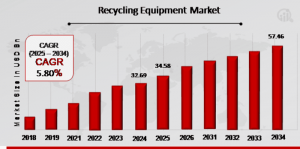Recycling Equipment Market Projected to Expand USD 57.46 Billion by 2034 at 5.80% CAGR | Metso, Kiverco, LEFORT GROUP
Recycling Equipment Market grows with rising environmental concerns, waste management initiatives, and demand for sustainable solutions.
Recycling Equipment Market A Comprehensive Analysis
The recycling equipment market has emerged as a crucial segment within the global environmental and waste management industries, playing an instrumental role in addressing the growing concern of environmental degradation and resource depletion. Recycling equipment refers to machinery and tools used in the process of converting waste materials into reusable forms.
This includes balers, shredders, granulators, compactors, separators, and sorting systems, which help streamline the recycling process across materials such as plastic, metal, paper, glass, rubber, and electronic waste. With increasing awareness about the adverse environmental impacts of waste accumulation and landfill usage, governments and industries worldwide are promoting sustainable practices, fueling the growth of this market.
Get Free Sample PDF Brochure: https://www.marketresearchfuture.com/sample_request/11732
Key Companies in the Recycling Equipment market include
Recycling Equipment Manufacturing
The CP Group
American Baler
Kiverco
General Kinematics
MHM Recycling Equipment
Marathon Equipment
Ceco Equipment Ltd.
Danieli Centro Recycling
ELDAN Recycling
Metso
Suny Group
Forrec Srl Recycling
BHS Sonthofen
LEFORT GROUP
Market Trends Highlights
One of the notable trends in the recycling equipment industry is the increased adoption of automated and AI-driven machinery. Traditional recycling methods often involve significant manual labor, leading to inefficiencies and safety concerns. The incorporation of artificial intelligence, robotics, and machine learning in recycling equipment allows for better sorting accuracy, higher processing speeds, and reduced human intervention. These smart technologies can differentiate between types of plastics or metals and sort them accordingly, significantly enhancing the quality and quantity of recycled material.
Another significant trend is the rise of e-waste recycling, driven by the exponential growth of electronic device consumption. With frequent device upgrades and increasing product obsolescence, electronic waste has become a major environmental challenge. This has led to a surge in demand for specialized recycling equipment that can safely dismantle and process e-waste, extracting valuable materials like gold, silver, copper, and rare earth elements.
Market Dynamics
The recycling equipment market is influenced by several dynamic factors, including regulatory policies, technological advancements, and public awareness. On the one hand, favorable government policies and incentives for waste reduction and recycling have encouraged manufacturers and municipalities to adopt advanced recycling equipment. On the other hand, challenges such as high capital costs, lack of skilled labor, and logistical issues in waste collection and segregation act as constraints to widespread market adoption.
The market is also shaped by the availability and fluctuation of raw materials. The rising cost of virgin materials makes recycling a cost-effective alternative, encouraging companies to adopt recycling as a core component of their supply chain strategy. Meanwhile, advancements in technology continue to reduce the operational costs of recycling equipment, making it more accessible to small and medium enterprises.
Buy Now Premium Research Report: https://www.marketresearchfuture.com/checkout?currency=one_user-USD&report_id=11732
Market Drivers
Several key drivers are propelling the growth of the recycling equipment market. Foremost among them is the increasing global emphasis on environmental conservation. Climate change, rising pollution levels, and diminishing landfill capacities have urged governments and organizations to adopt sustainable waste management practices. Recycling, being a fundamental component of environmental sustainability, has therefore witnessed increased investments and attention.
Secondly, the rapid industrialization and urbanization in developing regions such as Asia-Pacific, Latin America, and Africa have led to increased waste generation. These regions are now recognizing the importance of establishing structured recycling ecosystems, leading to demand for advanced equipment to manage municipal, industrial, and electronic waste.
Thirdly, the economic benefits of recycling act as a compelling driver. Recycling not only reduces raw material costs but also opens avenues for revenue generation through the sale of recycled materials. As circular economy principles become mainstream, companies are identifying recycling as a long-term cost-saving and value-creating strategy.
Market Restraints
Despite strong growth prospects, the recycling equipment market faces several challenges. One of the primary restraints is the high initial cost of advanced recycling machinery. While the long-term benefits of recycling are evident, the upfront capital investment deters small and medium-sized companies from adopting such solutions. Additionally, maintenance and operational costs further add to the financial burden.
Another major constraint is the lack of proper waste segregation at source, which significantly hampers recycling efficiency. Without proper sorting, recycling equipment often fails to operate at optimal levels, leading to contamination and reduced output quality. This is particularly evident in developing nations where public awareness and infrastructure for waste segregation are lacking.
Market Segmentation
The recycling equipment market can be segmented based on equipment type, material type, application, and region.
By equipment type, the market includes balers, shredders, granulators, separators, compactors, and others. Shredders and balers are among the most widely used, especially in metal and plastic recycling.
By material type, the market is segmented into plastic, metal, paper, glass, rubber, electronic waste, and others. The plastic recycling segment dominates the market due to the vast amount of plastic waste generated globally.
By application, the market serves industries such as municipal waste, industrial waste, construction and demolition (C&D), electronic waste, and automotive. Municipal and electronic waste are two rapidly growing applications.
Browse In-depth Market Research Report: https://www.marketresearchfuture.com/reports/recycling-equipment-market-11732
Future Trends
Looking ahead, the future of the recycling equipment market appears promising, with several transformative trends shaping its trajectory. One of the key future trends is the integration of Internet of Things (IoT) and cloud-based platforms in recycling operations. Smart recycling systems that provide real-time data on machine performance, maintenance needs, and waste streams will enhance operational efficiency and enable predictive maintenance.
Another anticipated trend is the growth of decentralized and modular recycling units, especially in urban areas and industrial parks. These smaller-scale systems allow for on-site recycling, reducing transportation costs and emissions. Such solutions are particularly appealing to businesses seeking localized and sustainable waste management options.
Additionally, biological and chemical recycling technologies are gaining attention. These methods allow the breakdown and reformation of complex materials, such as multi-layer plastics, that are currently not recyclable by mechanical means. As innovation continues, these advanced recycling techniques will complement existing mechanical processes, expanding the range of materials that can be effectively recycled.
Lastly, regulatory pressure and international collaboration will continue to play a vital role. Global agreements and frameworks aimed at reducing plastic pollution and promoting recycling-friendly product design will push industries to adapt their practices, further driving demand for state-of-the-art recycling equipment.
More Related Reports:
Precision Tool Market: https://www.marketresearchfuture.com/reports/precision-tool-market-23600
Process Control Automation Market: https://www.marketresearchfuture.com/reports/process-control-automation-market-23601
Professional Luminaires Market: https://www.marketresearchfuture.com/reports/professional-luminaires-market-23602
Metal Anodizing Market: https://www.marketresearchfuture.com/reports/metal-anodizing-market-23467
Air Filtration Media Market: https://www.marketresearchfuture.com/reports/air-filtration-media-market-24603
Combi Boiler Market: https://www.marketresearchfuture.com/reports/combi-boiler-market-24605
Commercial Oven for Bakery Market: https://www.marketresearchfuture.com/reports/commercial-oven-for-bakery-market-24608
Made In The USA Announces Top ARTIST Awards, and an Evening TAG Art Auction next weekend
NewSky Security Expands into Cyber Security Private Investigations to Combat Sophisticated Botnet and VPN Threats
CTO G. Vimal Kumar of Cyber Privilege Honored for Advancing Cyber Forensics and Digital Evidence in India
Kalendarium
Więcej ważnych informacji
 Jedynka Newserii
Jedynka Newserii

 Jedynka Newserii
Jedynka Newserii

Prawo

KE proponuje nowy Fundusz Konkurencyjności. Ma pobudzić inwestycje w strategiczne dla Europy technologie
W środę 16 lipca Komisja Europejska przedstawiła projekt budżetu na lata 2028–2034. Jedna z propozycji zakłada utworzenie Europejskiego Funduszu Konkurencyjności o wartości ponad 400 mld euro, który ma pobudzić inwestycje w technologie strategiczne dla jednolitego rynku. Wśród wspieranych obszarów znalazła się obronność i przestrzeń kosmiczna. Na ten cel ma trafić ponad 130 mld euro, pięciokrotnie więcej niż do tej pory.
Firma
Były prezes PGE: OZE potrzebuje wsparcia magazynów energii. To temat traktowany po macoszemu

Choć udział odnawialnych źródeł energii w miksie energetycznym Polski jest stosunkowo wysoki i rośnie, to ten przyrost jest chaotyczny i nierównomiernie rozłożony miedzy technologiami – wskazuje Forum Energii. Dodatkowo OZE potrzebują wsparcia magazynów energii, a zdaniem Wojciecha Dąbrowskiego, prezesa Fundacji SET, ten temat jest traktowany po macoszemu. Brak magazynów powoduje, że produkcja energii z OZE jest tymczasowo wyłączana, co oznacza marnowanie potencjału tych źródeł.
Infrastruktura
Wzrost wynagrodzeń ekip budowlanych najmocniej wpływa na koszty budowy domu. Zainteresowanie inwestorów mimo to nieznacznie wzrasta

Budowa metra kwadratowego domu w Polsce kosztuje od 5,55 do 6 tys. zł w zależności od województwa – wynika z najnowszych analiz firmy Sekocenbud. Najdrożej jest w Warszawie, gdzie cena za metr kwadratowy domu przekroczyła już 6,2 tys. zł. Na przyrosty kosztów budowy domu wpływają zarówno drożejące materiały budowlane, jak i wyższe wynagrodzenia pracowników. Inwestorzy nie rezygnują jednak z budowy domów jednorodzinnych, co ma związek m.in. z wciąż wysokimi cenami mieszkań czy też obniżką stóp procentowych.
Partner serwisu
Szkolenia

Akademia Newserii
Akademia Newserii to projekt, w ramach którego najlepsi polscy dziennikarze biznesowi, giełdowi oraz lifestylowi, a także szkoleniowcy z wieloletnim doświadczeniem dzielą się swoją wiedzą nt. pracy z mediami.









.gif)

 |
| |
| |
|